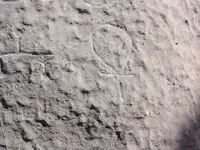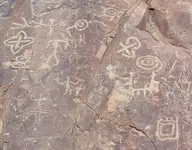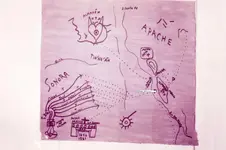In Book I of the Gold House, they claim the Bloody Hands site, Hembrillo Basin, VP, the Caballos, etc, are all shown on this map. So if that is true, what is what then? We should circle and label each part of the map if that is an accurate claim.
The Roman numerals in the "tally area" (just my description) are from top to bottom 68, 17, 1019, 50117, and 90. The symbols next to the roman numerals ( hashtag, capped hashtag, and half circle with arrow) may indicate what is being noted by the roman numerals (just a guess)
What does the capped hashtag represent?
What does the plain hashtag represent?
what does the half circle with the arrow mean?
Also, we see several spirals on the map, some circling cw, and the others ccw. A T-net member posted a story about a Spanish rock map south of Cortez, CO that he claimed to have deciphered, and he felt the spirals told you where to begin and end the trail shown on the map...
When an acquaintance in Las Cruces (not Roger Snow) first sent me a copy of this map scan ten or fifteen years ago, I assumed that it showed the Rio Grande with the Caballos above it, Victorio Peak and other sites above the Caballos, the Organs off to the right, and below the river, the Cookes Range on the right and the Santa Rita area on the left. You're right, though, it's daunting to try to look at the map as a whole without knowing what the symbology means. So let's just dive into it, piece by piece for the fun of it.
It's hard to say what any of the map symbols actually mean, since we don't know who produced it or what the symbols meant to him. He may have created and assigned his own meanings to all of them (hashtag variants, etc). Or, maybe they represent carvings to look for.
It's easy to assume that we're looking east with the Rio Grande being the double line running through with a near 90 degree bend on the right side, but maybe not. As markmar indicated, the ankh can arguably indicate "west" too, since it is associated with "eternal life", or "life after death" and has been linked to sunset, since that is where the sun goes when it "dies". As far as this map is concerned, do we have any reason to choose west for the ankh? Well, we do know there is a panel of unusual petroglyphs west of the Rio Grande toward the Gila headwaters/Santa Rita area that includes a number of Egyptian-like symbols including two obvious ankhs, one of which is shown below. In addition, these ankh carvings are precisely linked to a certain trail of spiral carvings nearby, one example of those also shown below. Collectively, the ankh, spirals and other symbols common to our Noss map lead to a location significant to some New Mexico treasure hunters. Perhaps all of this is coincidental to the Noss map, but this location's additional link to the Noss map will be further noted below.


It's unusual that two separate sun symbols are used on the map, the second one being the familiar half circle with rays, which usually means sunrise, or "east". Both sun symbols have seven embellishments. And as far as the ankh is concerned, it may mean something different than the sun - after all, there is a second ankh sitting at that 90 degree bend in the "river". Can both be used as suns? This is a bit confusing.
The "LCXVII" is not a proper Roman numeral. That being the case, maybe it, and the others, mean something else. It has been mentioned in the lore that a sextant was used with the Willie map to help find the cave. The sextant could be used to find latitude, but without an accurate timepiece and an ephemeris, that's all. By the way, do we know that the map we're discussing here is the "Willie map", or is it a second, separate map, a "Doc map?" Assuming it's the Willie map too, perhaps the "Roman numeral" symbols can be converted to coordinates or distances along a latitude line - one found using the sextant. By "coincidence", Victorio Peak, the Willie/Drolte/Hackberry canyon and the Santa Rita area site referred to above all sit on the approximate 32 degree 55 minute latitude line.
There's lots more. I wish we has a better resolution picture to work with - a lot of the finer detail in the map is hard to make out.
The Gold House writer did us a disservice with the lame graphics and photos used in the book.






